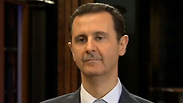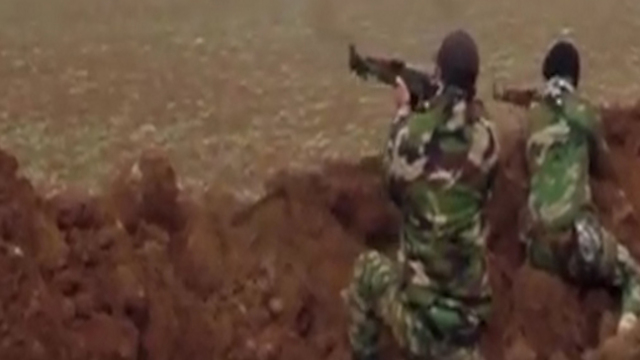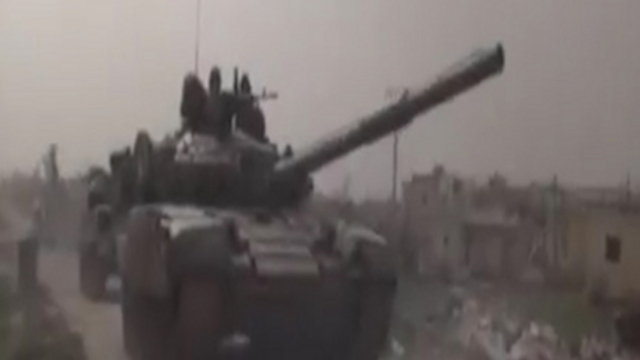
Assad, Hezbollah, and Iran's onslaught towards Israel
Map shows attempt by 'axis of resistance' to secure towns and strategic points in order to drive rebels out of Israeli border region.
A major offensive by the Syrian army in its southern front, in cooperation with Hezbollah and Iranian elements, continued on Thursday, not far from Israel's Golan Heights border.
Mere days after the start of the operation, the Syrian Armed Forces declared on Wednesday night that they had made significant achievements in the bloody land battles.
So far, Assad's soldiers, aided by Hassan Nasrallah's Hezbollah fighters, successfully retook three towns in the strategic triangle that lies between the Damascus suburbs, Quneitra suburbs, and Daraa suburbs. These include the villages of Deir al-Adas, Al Dnaj, and Deir Makas, in addition to a number of strategic hills, as seen in the map below, published by Al Akhbar.
Media outlets associated with Assad and Nasrallah have been following events on the front very closely, broadcasting videos of land battles accompanied by heavy artillery, as well as the loot purportedly found in conquered areas.
Hezbollah's Al Manar network claimed on Wednesday that they had found Ameriacn and Israeli equipment and weaponry alongside an Emirati aid package.
Meanwhile, the media outlets have attempted to convey a sense of panic on the part of the rebels and local residents. Among other things, they reported attempts by rebels to reach an agreement with Assad's forces in the face of defeat.
The rebels have tried to limit the damage, claiming that the areas taken by Assad's forces with the help of Hezbollah and Iran are insignificant.
A look at the operation's targets reveals the army's hopes to drive the rebels and al-Nusra front further away from Damascus and its suburbs. They also seek to prevent the rebels in Quneitra and Daraa, who have over the last four years nearly become a united force, from linking up.
The army further feels the need to regain control over the area adjacent to the Israeil border and the Quneitra crossing in particular.
Nasrallah spoke of this topic at length in his most recent speech, calling the rebels "the Syrian South Lebanon Army", which cooperates with Israel in order to create a buffer zone like in south Lebanon.
Along the same lines, there is also the goal to remove the rebels from the surroundings of the Jordanian border in Daraa, but there is at the same time a desire to prevent at any cost the possibility of the rebels and al-Nusra front spilling over into south Lebanese territory from the Syrian Hermon area.
In fact, in north Quneitra the Syrian regime has a much stronger hold than in other areas, but the rebels are in locations such as Beit Jinn, not far from the Lebanese border.
And it seems that the Syrian regime is no longer hiding the fact that it receives help from Iran and Hezbollah, while media outlets associated with Hezbollah and the Assad regime speak mainly of the Syrian army.
The Asharq Alawsat newspaper reported on Thursday morning that a field commander quoted on Syrian national television said: "The military operation launched by the Syrian army in the south continues under the leadership of Syrian President Bashar Assad and in cooperation with the axis of resistance – Hezbollah and Iran."
The Al Mayadeen network has begun referring to the "Syrian army and the resistance" as a single force when referring to the onslaught.
Commentators linked to Hezbollah have also been openly admitting that the operation is by the "axis of resistance" and not just the Syrian army. The most senior is Ibrahim al-Amin, editor of the pro-Hezbollah daily Al Akhbar, who related on Wednesday that the so-called axis already decided to begin the operation to retake southern Syria before the airstrike attributed to Israel.
"The decision to prevent southern Syria from falling into the hands of Israel's collaborators is more strategic than any other," he said, "and is equally as important as the decision to prevent Damascus from falling to these same collaborators.
"The decision was made to allocate everything required to make this decision a reality, and everything required in case of escalation of any kind, direct or indirect, that could occur in the region, including the possibility Israel's involvement in further aggressive actions."
Military expect and strategist Amin Hatit, known to be close to Hezbollah, told Asharq Alaswat Thursday morning that "the Golan front currently serves as an example of the first battlefront in which the three components of the axis of resistance (Iran, Syria, and Hezbollah) are operating.
The axis is currently testing its capability for joint military action in the field, and it appears that the initial results surpass all expectations. Within 48 hours, goals were achieved for which ten days were allocated."
Hatit explained that the operation has four strategic goals: "The first is to prevent the Israeli buffer zone protected by al-Nusra Front. The second is to consolidate the defense around Damascus. The third is directly related to the resistance in Lebanon, which is trying to prevent the opening of a southeastern front (near the Lebanese border), which would exhaust it and involve it in a war of attrition. The fourth goal is to block the American plan to open a war against Syria using the Jordanian option."
Meanwhile, in light of the danger posed by the Islamic State group, the Lebanese army – together with Hezbollah – is expected to soon launch a wide-ranging security operation to prevent its advance.
Speaking of Jordan, alongside the open discussion of the fact that the operation is intended to disrupt Israel's purported plans near the border, the Hashemite Kingdom has also been targeted by Hezbollah's commentators and leaders of the Syrian regime.
They claim it is actively cooperating with those plans, and that despite Jordan's talk of a political solution in Syria, it knowingly allows terrorists to enter through its borders and trains them in military camps.
These claims were vociferously denied this week by Mohammed al-Momani, the Jordanian government's spokesman, after the Syrian foreign minister sharply denounced Jordan.
Meanwhile, a photo has circulated in recent days allegedly showing the commander of the Revolutionary Guards' Quds Force, Qasem Soleimani, in southern Syria with Syrian army soldiers.
The image was not independently confirmed, but some Arab media outlets interpreted it as another sign of Iran's deep involvement in the operation in the south, and in the Syrian war in general.
On Wednesday, Soleimani participated in a ceremony taking place in southeast Syria marking the anniversary of the Islamic Revolution and praised Hezbollah's attack at Mount Dov last month, which, he said, succeeded despite the fact that the IDF was at peak alertness in preparation for an expected response to the strike attributed to Israel in Quinetra.
He added that global Zionism has been suffering more and more defeats by the "resistance", and that one could see the Islamic Revolution's effects in the entire region between Bahrain and North Africa.














